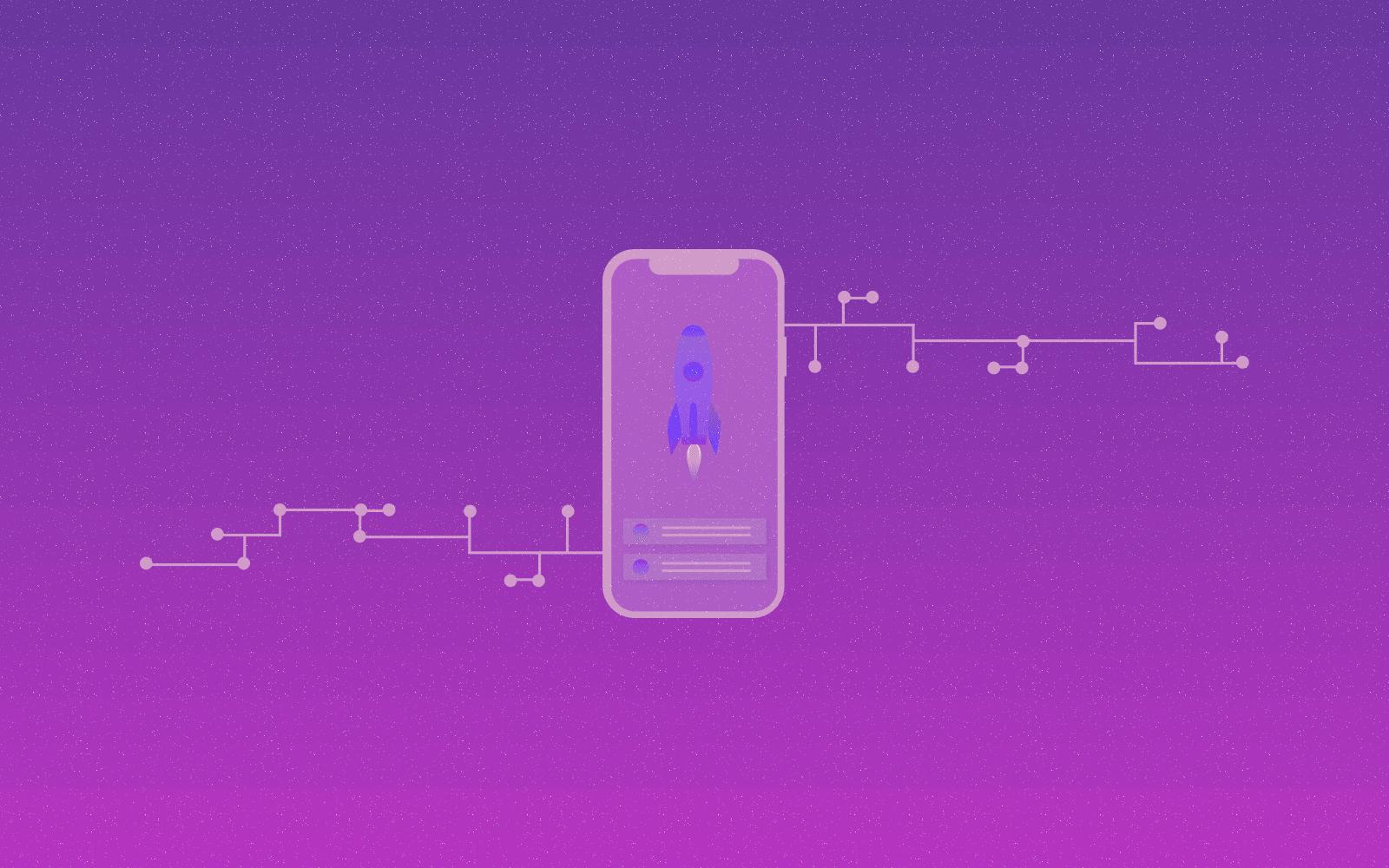
How to Launch an App: a Guide Through the Process of a Successful Mobile App Launch
As a society, our dependence on mobile devices grows exponentially and, along with it, a growing market demand for apps that would answer the customers' needs. This strategy brings to the table a virtually infinite range of branding possibilities.
To back up this claim with numbers, let us now present you with some data:
- According to Data AI's Report, the general app store spending has reached a dizzying sum of $171 billion.
- Global IT expenditures are predicted to reach $5 trillion in 2024, representing an increase of 6.8 percent compared to 2023,
- The number of application downloads also rose steadily after the decline in 2022, receiving a vast sum of 257 billion.
Therefore, it is understandable that we witness a rising demand for mobile app development agencies. However, as the market becomes even more competitive, you need to prepare yourself. A well-informed decision-making process will allow you to promote your app successfully and reach the audience that will find your solutions viable.
That's why today we will dive into how to launch an app - so that it will rank higher in the app store and bring your business to another level. We will provide insights backed by our over ten years of experience in the IT market, gathered by working with clients from various industries.
How to Successfully Launch an App? Prepare Before Working on App Launch Strategy - Stage 1
“The secret of getting ahead is getting started. The secret of getting started is breaking your complex overwhelming tasks into small, manageable tasks, and then starting on the first one."
— Mark Twain
As people commonly say - first things first. Setting a solid base for your app launch process will ensure the further steps will go smoothly. The smooth execution of the app release and production will increase the chances that it will quickly start generating revenue, and thus recoup the costs associated with its promotion and production. Thus, get ready to approach this stage carefully - as it will become fruitful in the future.
Address Your Goals and Objectives Beforehand
The sole idea is usually not the best basis for app development. To make sure it will become a landmark of your success, you need to carefully address your aims and objectives.
This process should be two-pronged. After all, you want to ensure your company's stable revenue and the viability of the app; but on the other hand, the purpose of the app is to fulfill the needs of your customers. We discuss the latter aspect below. For the former, think about the context in which your business operates, the challenges you face, and the direction you would like to steer it.
By doing so, you also study the market situation, which allows you to assess whether your application's release will be profitable at this time. Perhaps it is worth waiting for another season? Or maybe there are periods in your industry when customers are less active than usual? Take all this into account when planning your app's release - this way you will ensure your app is more likely to succeed.
Find the Right Audience and Value Proposal
Our experience indicates that the most successful app ideas are backed up by solid data. Before putting the whole development in motion, it is worth going through the Google Store and Apple App Store to browse statistics and see the ways customers treat those products. Gathering such information is essential to determine what is currently trending and forecast the probable demand for services within your sector.
Again, let's support our claims with reliable data. Statista's report suggests that in terms of retaining users, a vast majority find it difficult to many of them struggle to maintain stability. Only between 1.5% and 11.3% of users continue to use an application 30 days after installation. This percentage provokes us to ask the valid question - where lies the secret of the apps frequently used by their audience?
The answer to it lies within properly conducted user research. There are multiple methods to get the valuable data, the most well-known including:
- surveys,
- feedback analysis,
- focus groups,
- product testing.
Both quality-and-quantity-based methods should complement themselves, allowing you to see the multi-faceted picture of how the market looks like and what it would respond enthusiastically to.
Remember: Each of the tools should apply to a proper stage of the app's development. That way, you will provide your audience with user-driven features along with pixel-perfect design. Your app will also evolve according to the market's fluctuations, allowing it to maintain its level of popularity.
Carefully Calculate Your Budget
The ideation phase cannot be concluded without determining the cost of launching an MVP. We describe this process in detail in our blog article on the differences between contract types for app development. Creating a proper budget demands several steps, which include:
- Defining your project's requirements. There, we outline the necessary features, design, and branding that will allow your app to stand out in the marketplace.
- Choosing the members of your development team. You have the option to choose in-house or to outsource your app development process.
- Creating an initial app design quote. Consider the project's complexity, as well as the salaries, vendor fees, as well as extra cost of software and hardware foreseeable expenses.
- Account for the ongoing costs related to keeping your application within the market. These include the cost of maintenance, marketing, or hosting fees.
How to choose the most trustworthy metrics to ensure that the app receives the best possible acclaim? Consider choosing the measurable goals focused on its launch. Among the most feasible ones, we prefer the ones that highlight the average app active install rate. By doing so, you can harness such information about retention rate, its marketplace average rating, as well as the revenue generated from selling the app, if you decide to such a business model.
You can delve deeper into the process of creating a budget for software development with the articles below:
- Web App Development Cost,
- Mobile App Development Cost,
- Website Development Cost.
Create a Timeline to Submit Your App
One of the most essential things within project management is to create a valid, reality-based timeline. By doing so, you keep control over the scope of every stage of the app development.
The time required for a successful app launch can vary due to the complexity of the application and the technology applied during the project. However, the team's size and the expertise level of its members also play a crucial role in determining the schedule for launching the app.
To receive a precise schedule for a successful mobile app launch, reach out to us. With our mobile app developers and business development managers, you will get a quote along with a precise timeline framed to your needs.
Find Means of Reaching Your Audience - a Successful App Marketing Strategy
To create an app is only the first step. Your launch strategy should include a proper marketing strategy, so it would eventually reach a desirable audience. We will delve deeper into this issue, as it often becomes a downfall of even very promising, well-developed MVPs.
To make the mobile app launch process smooth, consider several marketing-related aspects:
- The definition of your success criteria,
- The choice of a potent pricing model,
- The development of branded screenshots and visuals for promotional purposes,
- Recording a promo video,
- Building and maintaining a presence within social media.
Find Your Success Criteria - Because None of the Statistics Can Go Unnoticed
The first rule of successful marketing practices is to make every action measurable. Follow it while launching your mobile app, starting with choosing the criteria for its success. There is a whole range of such criteria to choose from. Their choice depends mostly on your application's business goals and objectives. As we have mentioned before, defining them clearly will have a vast influence on the future whereabouts of your projects - starting with this stage.
Among the criteria, the most frequently chosen are:
- Acquisition - meaning the number of new downloads within the clearly defined time frame;
- Retention - describing the number of end-users who would use your app after a given period;
- Activation rate - defining several users who would decide to start a free trial of your application or partake in an action defined by you as a milestone;
- Churn rate - the number of users who back down and uninstall your application.
Choose a Pricing Model to Optimise the Revenue From Your Application
One of the most vital tasks in the preliminary efforts while creating an application monetisation and marketing strategy is choosing the pricing model you will follow. This stage involves the decision about the means of receiving revenue generated from your app. It also heavily influences the way you would present its features and functionalities. Due to that, you should take it into close consideration - as a misstep would result in your app not receiving acclaim among the users.
As you can see, choosing an appropriate monetization model for your app impacts the whole development process. Among the most popular choices you can find:
- Free - users can download your solution from the app store for free. The monetisation process goes through advertisements or other strategies.
- Paid - your application is available in-store for a defined sum of money paid in-store.
- Freemium - your app is available in-store for free, but the features of your app are limited. To enjoy its full range of functionalities, the user has to pay extra.
From Videos to Mockups - Creating Marketing Materials
Let's say your app features many useful and well-thought-out functionalities. However, to present it most appealingly, you need a branded set of marketing visual materials that will help in establishing brand awareness around your app. From its UX design to icons, branded graphics, and logos - they will play a valid role in optimizing its profile in the app store.
While considering your marketing approach, also account for the necessity of creating a website for your app. This would concede with your aim to create a multi-channel promotion strategy and reach your audience from different angles.
Connect Your App with Real Users Through Social Media
Social media marketing strategy is a challenge whose importance is often highly under-appreciated. That is unfortunate - as choosing a proper medium to promote your solutions can result in getting to an audience that would appreciate them.
Social media do that thanks to the metrics they offer. With enough knowledge and a properly defined audience, you can use them to reach the people whose age or area of interest covers what you offer.
Also, keep in mind that different media represent different activities. For example, Linked In focuses solely on business-related issues. It is a perfect medium to boast your professional knowledge, but if you aim for a cheaper and more informal platform, consider using other social media.
Stage 2: Mobile App Development - the Most Important Steps Before Launching an App
Congratulations - we have just done plenty of solid groundwork so that we can proceed with further steps leading to a successful release of your mobile app. Now, the bulk of the work rests in the hands of the mobile application development agency to which you have entrusted the project execution.
However, this does not mean you are left to wait passively for the fruits of the developers' labor in the following weeks. We take great care to keep our clients in the loop. That way, you stay informed about the project's progress - and we can rely on your outlook regarding the nuances of your sector's whereabouts.
Design and Prototype Your Solutions
Having all the extensive data prepared in the previous steps, now we can proceed to prepare solutions suited to your app's needs. This step's timeline highly depends on the complexity of the app and demands through cooperation between the business development team and our UX and UI designers.
Prototyping and wireframing do not constitute creating a solid product. Instead, it is a guideline on the final product's desirable shape. They do not include specified graphic details or fonts, instead offering the basic premise of the app's functionalities.
To create wireframes and prototypes, our designers use mostly Figma.
Develop the Application
Now, it's our mobile app developers' turn to put things in motion. They code solutions presented in the prototype to include them in the program's core functions.
This stage's progression depends on the general design decisions made during the earlier stages of the project. This also impacts the forecasted timeline.
Test Your App to Ensure Its Soft Launch
It is crucial to prioritize stability and security when developing the app to guarantee a seamless and satisfying experience. A team of seasoned testers and QA specialists identify and address any potential issues that may arise. They understand the importance of delivering a product that meets the highest standards of performance and safety.
Optimize Your Keywords For SEO and App Store Purposes
Even the most innovative solutions can go unnoticed if not promoted properly. One of the most vital and, unfortunately, often overlooked actions you can take is placing keywords within the app name and description while posting your product into the app marketplace. Optimizing your mobile app launch in this context allows you to measure the objectives you have defined beforehand, as well as reach the audience that will enjoy the presented solutions.
Mobile App Launch
Congratulations - the launch day has come! As much as it is a celebration occasion, it does not mean that your efforts come to an end just yet. To launch an app successfully, you need to provide your audience with informative and compelling media coverage. Depending on the software's and audience's type, your communication may vary.
Beta Launch: Testing App Before Its Release
As the app is ready to go, you probably are on your toes to upload it to the Apple App Store and Google Play. However, it is worth introducing the pre-final version to a carefully selected target group of beta testers. There are two ways to approach this stage:
- Either you share the program's beta version with your testers,
- Or you can utilize such tools as Google Play Console or Apple TestFlight.
That way, you can do the last check-up of your app weeks before the final release.
App Store Optimization - Best Way to Promote Your App in Store
Being on the eve of the app's release, it's a good idea to make sure that all the materials necessary to promote your product are on hand. Although their form will depend primarily on the marketing strategy you have chosen, we have decided to briefly outline some of the most popular activities that we usually do during a mobile app release:
- Quality Assurance: Is your app stable? Does it provide a maximum level of security? Will its functions serve your customers properly? If so, your app is ready to go!
- App Analytics: It is necessary to observe the application users' behavior to make well-based business decisions. To get them in action, set up the trackers and make sure the views, filters, and other options are properly in motion.
- Social Media: Ensure your marketing channels are prepped and ready to promote the app as you launch it.
- Website & Landing Page: Is your website operational? Have you optimized its content for SEO purposes? Have you filled the app title with relevant keywords? Does its page speed allow for comfortable and efficient search?
- Press Kit: To successfully launch an app, you must have a well-rounded press kit. It should contain the most vital visual components of your marketing strategic resources, including screenshots, video demos, logos in different color variants, as well as the press release, and company information.
- Video Trailer: A video provides your audience with a quick recap of your app's functions, allowing you to enjoy the high rate of your product's organic download.
- Push Notifications: Allows you to keep your audience engaged with regular information about app's updates
How to Launch an Android App? Best Practices for Google Play Store
Every app store has its submission guidelines you should follow. Android App Store is a potent platform with over 111.3 billion downloads in 2021 [3]. That, along with it being easier to set up than the Apple App Store, makes it a platform immensely popular among distributors.
Let's see how to prepare your app on Google Pay to optimize its download and retention rate:
- Create two accounts: a developer account in the Google Play Console along with a Google Account under your company's name;
- Cover the payment for the account and fill in the details to complete your developer account registration process;
- Now, take care about filling in the information regarding your app distribution and marketing materials;
- Upload the build to Google Play Console and set up your privacy policy;
- Maintain the configuration for sale. This stage includes subscriptions or in-app purchases you have planned in the monetization strategy phase;
- Send the build to Google Play.
How to Launch an iOS App? Successful Apple App Store Optimization
As stated in LifeWire [4], in 2020, there were a total 180 000 applications available on the App Store. Compared to Google Play, this number may seem a bit underwhelming. However, the iOS App Store is widely known for its strict rules regarding the standards that the apps displayed there must meet. This is why in the case of software designed particularly for this platform, following the guidelines is obligatory - and oftentimes demanding,
This meticulousness, however, comes with a reward. As your application finds its place in the iOS Store, statistically speaking, it enjoys a more frequent usage ratio than its equivalents in Google Play. That is why we recommend using this solution if you want to promote a unique application with well-thought-out functionalities.
Now, let’s break down this process and see how successfully launch your app on the iOS App Store:
- Create a developer account and access App Store Connect
- Create a new app and fill in the product page
- Set the roles, certificates, identifiers & profiles
- Upload your app build
- Test your app
- Fill in the version information
- Choose the release date
- Set age ratings
- Submit your app for review
Inform the Influencers and Your Press List About the App's Release
Before D-Day, you need to prepare your partners to release the press materials and share promotional content through the pre-planned marketing channels. By doing so, you achieve two things:
- attracting the attention of media representatives,
- garnering the audience.
Press releases are crucial for app launches. An attention-grabbing headline, compelling narrative, and clear app description with a strong CTA are essential - whereas successful distribution involves a balance between newswire services and targeted outreach. Consider measuring their impact using KPIs and tracking tools to assess media engagement, social mentions, and market impact - and, in turn, successfully prepare your strategy for future endeavors.
How to Successfully Launch Your App? Conclusion
To achieve a successful mobile app launch, strategic planning, collaboration between design and development teams, and effective marketing are essential. To set the stage for success, it's imperative to thoroughly identify your goals, audience, and budget, and conduct extensive market research. During development, prioritize stability, security, and user-centric design. During the launch, leverage a combination of marketing channels, engage influencers, and effectively communicate with your target audience to drive downloads and propel your app to the top.
With diligent execution and a focus on delivering value to users, you can realize the full potential of your app in the ever-evolving digital landscape.
Sources:
- AI Data State of Mobile Report for 2024:
https://www.data.ai/en/go/state-of-mobile-2024/
- Statista - iOS and Android App User Retention Rate:
https://www.statista.com/statistics/259329/ios-and-android-app-user-retention-rate/
- Statista - the number of app downloads in Google Play from 2018 to 2022
https://www.statista.com/statistics/734332/google-play-app-installs-per-year/
- LifeWire - How Many Apps Are in the iOS App Store?
https://www.lifewire.com/how-many-apps-in-app-store-2000252
Share this post:

Stay updated with new posts
Get notifications when new articles are posted. You can always unsubscribe from the list.
Softnauts is committed to processing the above information. Read Privacy Policy

